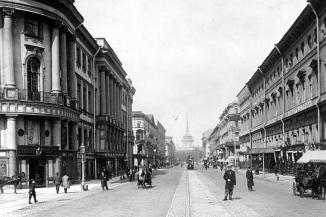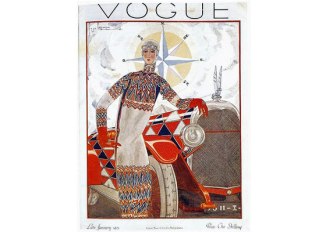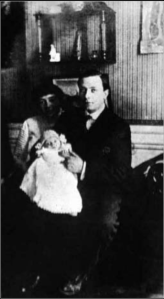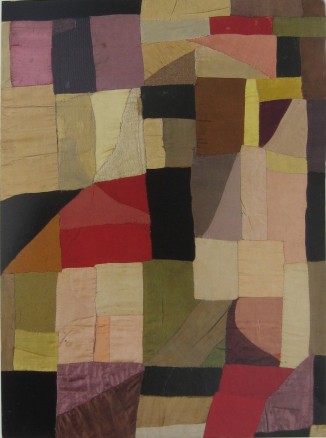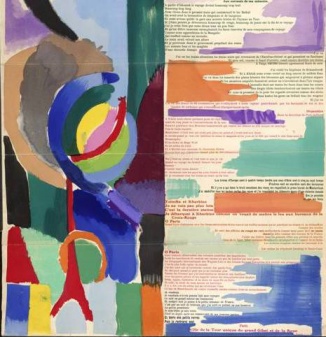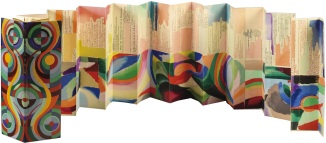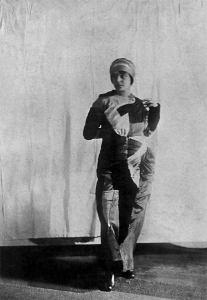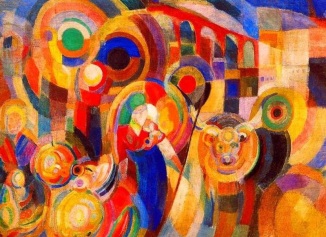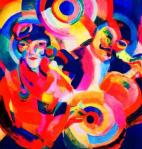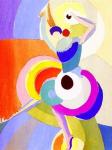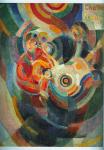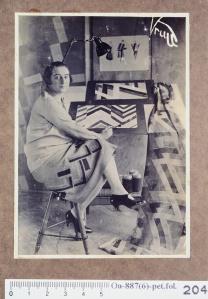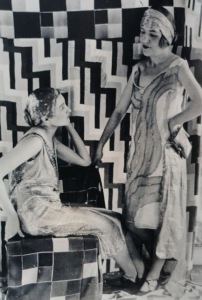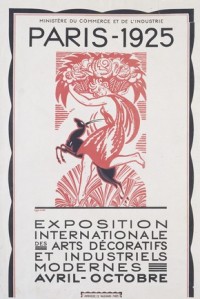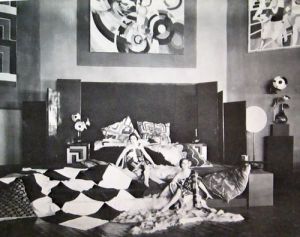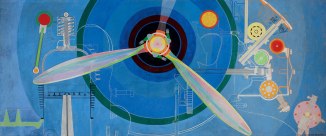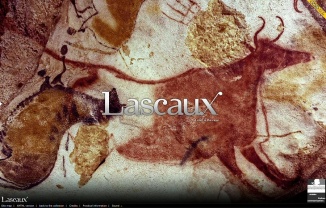Category Archives: .France
Water Color Story Puzzle
- 1836, born in Boston
- 1857, apprentice
- 1861, Abraham Lincoln Inauguration
- 1861-1865, Civil War
- 1863, Home, Sweet Home
- 1871, The Country School
- 1872, Snap the Whip
- 1873, The Red School House
- 1873 – 1876, Sailing the Catboat and Breezing Up
- 1883, Incoming Tide
- 1884–85 and 1898–99, Winter trips
- 1899, The Gulf Stream
- 1910, Who am I?
- PROJECT: A Watercolor Adventure
- GALLERY
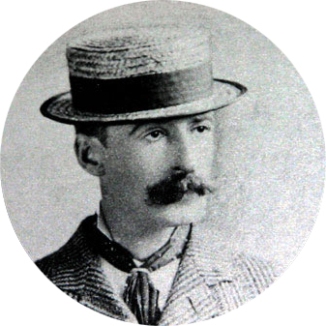
I was born on February 24, 1836 in Boston, MA the second of three sons. My mom was an amateur watercolorist and my father a hardware merchant. I attended local schools in Cambridge, MA after my family moved there in 1842. How old was I then?
I had a happy country childhood living in rural Cambridge. Together with my two brothers, I spent many hours in the woods and by the river fishing, swimming, boating and romping along the beaches. I loved to draw and I was always drawing! Here’s a cartoon in the style of the time depicting my father’s trip to join the Gold Rush.What year do you think it was?

Astride a rocket that looks suspiciously like a fishing fly, the father manages to cross the Rockies before crashing on a group of forty-niners.
1857, apprentice at Bufford’s lithography
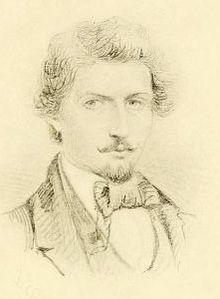
“Boy wanted; apply to Bufford, lithographer; must have a taste for drawing; no other wanted.”
Here I am in 1857 as an apprentice, my first and only full-time job, at Bufford’s, Boston’s leading lithographer. This was not a paying job; in fact, I had to pay him for the privilege of learning his craft.
At 21 I started working as an illustrator for a news magazine, Harper’s Weekly. In 1859 I moved to New York to be closer to the publishers that commissioned my illustrations and to pursue my ambitions as a painter. My early work for Harper’s was primarily to create line art drawings from photographs. At the time pictures were printed by “stamping” them from a large wood block. Here is my illustration for the March 16, 1861 edition of Harper’s Weekly. It presents the Inaugural Procession of President Elect Abraham Lincoln.

Home, Sweet Home, c. 1863
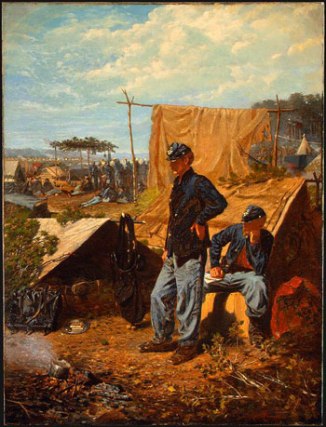
I was sent by Harper’s to the front as an artist-correspondent during the Civil War. In Home Sweet Home we see the soldiers in the camp. The band in the background is supposedly playing the song “Home Sweet Home”. The soldiers are wearing brown boots which they were supposed to polish black, but they were usually too busy.
Can you notice the hard biscuits on a tin plate? Do you think they were sweet?
Instead of covering the horrors of war as requested by my editors, I chose to paint the quiet scenes of life behind the deadly action. While these images weren’t what the editors originally wanted, the subscribers appreciated them and they launched my career as a painter!
How did people report news then in the nineteenth century, when camera was not common and it was expensive or difficult to develop prints?
The Country School, 1871
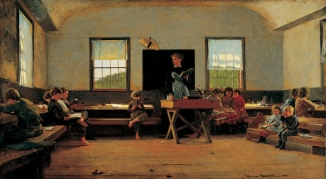
Can you spot:
- the teacher’s hat hanging on the wall?
- the lunch pails in the corner?
- the book, bell, and vase of flowers on the teacher’s desk?
- the wilted flowers on the floor?
Who do you think is the little crying boy, and why is he sitting on the girls’ side of the room?
Can you spot any differences between these paintings?
What time of day is it? How do you know?
What time of the year is it? What hints can you find in the painting?
The Red School House, 1873

 BLACKBOARD, 1877
BLACKBOARD, 1877
Can you find my signature on the blackboard?
1873 – 1876, Sailing the Catboat and Breezing Up
Compare Sailing the Catboat and Breezing Up. They are very similar.
How are they alike and how are they different?
Incoming Tide, Scarboro, Maine, 1883
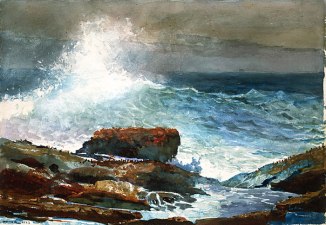
Can you describe the sea?
Winter trips, 1884–85 and 1898–99
Where do you think I was traveling?
Imagine that you could travel to these places. Which scene is most appealing to you? Why?
The Gulf Stream, 1899
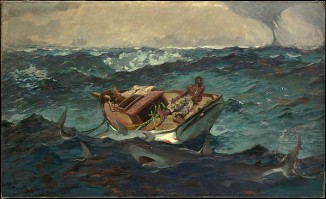
What do you notice in this paining?
What do you think, what happened and will he survive?
What is the Gulf Stream?
“You will see, in the future I will live by my watercolors.”
Winslow Homer (February 24, 1836 – September 29, 1910)
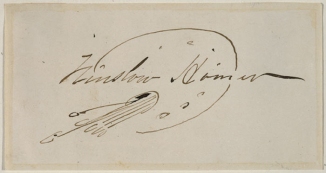
How would you describe his art style? Is he an impressionist, abstract, or realist painter?
PROJECT: A Watercolor Adventure – Me and the Sea – Seascape painting
Paint a story in the style of Winslow Homer:
- Think of a sea memory
- Imagine a sea adventure
- Be inspired by one of Winslow Homer’s seascape paintings
Medium: Watercolor/ Oil pastels, White paper
Instructions:
Using a half-sheet (full sheet for K-1) of watercolor paper, color in an enlarged picture of a water spout, rain storm, super wave, sharks, scuba diver, mountain climber (person or goat), nature preserve, etc. It is important to try to fill the page with the activity.
Save the paint brush and water until much of the artwork fills the paper. After some water (squeeze out the excess) and brush work, more details can be added by applying more oil pastels to it. This keeps the work crisp and not flowing together.
As always, don’t forget your artist signature!
Can you give your story a title?
Last, if you have time, write the story of your adventure.
At the end of the class you will set-up a gallery with all the stories in the order you want for an even bigger adventure!
Henri Matisse: Cut-Paper Art
- Itinerary
- Fortunately, Matisse
- A Secret Color
- A Magic Gift
- The City of Light and Color
- Painting like Children
- Wild Beasts
- New World
- Drawing with Scissors
- Project
- Gallery Play
- Interractive Art
Where will we art-travel today?
Henri Matisse (31 December 1869 – 3 November 1954)
“If my story were ever to be written truthfully from start to finish, it would amaze everyone.”

Henri Emile Benoît Matisse was born in a tiny, tumbledown weaver’s cottage in the textile town of Le Cateau-Cambrésis at eight o’clock in the evening on the last night of the year, 31 December 1869.
- Le Cateau-Cambrésis was an industrial, grey town in the extreme north of France near the Belgian border.
- The house had two rooms, a beaten earth floor and a leaky roof. Matisse remembered long afterwards the rain that fell through a hole above the bed in which he was born.
- Life was hard in the North. His father was a grain merchant whose family were weavers. His mother, Anna Heloise Gerard, was a daughter of a long line of well-to-do tanners. She ran the section of her husband’s shop that sold housepaints, making up the customers’ orders and advising on color schemes.
Fortunately, the colors left a lasting impression on Henri. The artist himself later said he got his color sense from his mother, who was herself an accomplished painter on porcelain, a fashionable art form at the time.

Matisse’s childhood memories were of a stern upbringing. He was a dreamer and rather frail kid, not very well adapted to the rigors of the North.
- He was a proper student, but with no ambitions of his own.
- He followed his father advice to go to the law school for a better life.
- When he was 21 years old, an attack of appendicitis constrained him to the hospital bed.
Fortunately, his mother brought him an art set during the period of convalescence and this gift changed his life!
“From the moment I held the box of colors in my hands, I knew this was my life.”
 Two years later in 1891 Matisse returned to Paris to study art at the Académie Julian where he learned the fundamental lessons of classical painting.
Two years later in 1891 Matisse returned to Paris to study art at the Académie Julian where he learned the fundamental lessons of classical painting.
- Traditional painting wasn’t his style and he left for another studio.
- He experienced hard financial times as a student and with a family of one daughter and two sons.
Fortunately, Paris was a center of arts and science at that time, it was the City of Light and Color!
Scientists discovered new chemical elements that were used for more brighter pigments.
Chemist Michel Eugène Chevreul created the color wheel and discovered that complementary colors placed together look stronger, brighter and seem to vibrate.
The new understanding of colors took the art scene by storm.
Many artists were fascinated by these new colors and developed new styles of painting.
One artist in particular used the simultaneous contrast of colors, do you remember the artist?
The answer is here!

In 1905 Matisse arrived in the charming Catalan port of Collioure, in the south of France. He was so impressed by the intense light of the Mediterranean that he invited the painter André Derain. Together they painted pink seas, red mountains and green noses.
They were breaking all the “rules” of painting, using bright colors in new imaginative ways.
They showed things not as they really were, but how they felt them to be.
“We painted like children in the face of nature.
Other artists joined the color movement and they exhibited their works at the Salon d’Automne (Autumn Salon, the modern art exhibition held in Paris at the beginning of the twentieth century).
- Visitors were shocked by this new type of art
- Critics called them “Fauves” (“wild beasts” in French)
- The unconventional landscapes and figure paintings caused a public scandal because no one had seen anything like that before. The greatest outrage was caused by “Woman with Hat”
Fortunately, a group of art collectors from San Francisco (Leo and Gertrude Stein, Sarah and Michael Stein) fell in love with their paintings and started to collect them and support the artists (Matisse, Picasso, Braque among others). The Steins influenced other collectors in the area and San Francisco is today one of the best repository of artworks by Matisse!
“What I am after, above all, is expression, ” … “the feeling I have for life”
What I dream of is an art of balance, of purity, and serenity”

In the spring of 1930, Matisse made his first trip to United States, visiting New York, Chicago, Los Angeles, and San Francisco before setting sail for Tahiti. As the San Francisco Chronicle reports, the artist made the most of his stay in the Bay Area, visiting Mount Tamalpais, Twin Peaks, the aquarium, Fisherman’s Wharf and the California School of Fine Arts (now the San Francisco Art Institute).
He also saw The girl with green eyes again as part of an exhibition at the Galerie Beaux-Arts on Geary Street.
Fortunately, the painting was no longer as shocking as it had been when it first arrived in San Francisco in 1911 and its appearance in the local paper this time bore the caption “Considered Excellent”.
“go no further than New York, so impressed am I with this new world. It’s big and majestic, like the sea.”
Tahiti was very hot and humid and I “did absolutely nothing except take bad photographs”



In 1938 Matisse was an accomplished artist approaching his 70s. His work had taken a toll on his health and he moved to Hotel Regina near Nice.
- German troops invaded France in 1940
- Ill health and major surgery in 1941 confined Matisse to a wheelchair
- Because of the war, Matisse moves out of Nice to the nearby town of Vence, to a villa called “Le Rêve” (The Dream).
Fortunately, Matisse found the strength to start something completely new. Although he was not able to paint anymore being confined to a wheelchair and bed, he began to cut out shapes on large sheets of paper painted with gouache (a water-based, opaque, quick-drying, matte paint).
Matisse was drawing with scissors!
“Paper cut-outs allow me to draw directly in color.”
“You see as I am obliged to remain often in bed because of the state of my health, I have made a little garden all around me where I can walk… There are leaves, fruits, a bird.”
In 1947 he published Jazz, a limited-edition book containing prints of colorful paper cut collages, accompanied by his written thoughts.
PROJECT: Cut-Paper Art
Using colored paper and colored paper scraps, each child will create a picture using scissors to ‘draw’. Henri Matisse used this methos in his later years and continued to work with his very bright colors.
SUPPLIES
Scissors, a square of white background paper, an assortment of construction paper scraps, glue.
PROCEDURE
Cut shapes out of paper without drawing them, and arrange them on the background paper. It is interesting to have only curved shapes or straight lines. Move them about before you glue them down. Perhaps they would like to limit the color selection or shape to be able to make something in particular. However, Matisse was known for his wild color combinations.
THEME: Goodbye, Winter! (in celebration of the Spring Equinox)
What are some of your favorite things of winter?
- First, make a list with your favorite things and write it on the back of your paper.
- Then ‘draw with scissors’ as many favorite things as you would like, these will be the vocabulary of your painting.
- You can choose any colors you like, it doesn’t need to be realistic colors!
- Next, ‘play’ with your favorite things on the paper and create a joyous winterland.
- When you are happy with the arrangement, you can start gluing.
Sonia Delaunay: Designs for Clothing or Furniture
- Who is Sonia Delaunay?
- What is her background?
- How did she start her career as an abstract artist?
- What are her key artworks?
- Where has she exhibited her work?
- What color is this dress?
- Project
- Show Time!
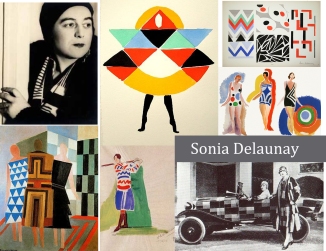
Who is Sonia Delaunay?
Sonia Delaunay – Terk (November 14, 1885 – December 5, 1979)
Sonia Delaunay was a multi-disciplinary abstract artist and key figure in the Parisian avant-garde. Alongside her husband, Robert Delaunay, she pioneered the movement Simultanism. Her exploration of the interaction between colors has created a sense of depth and movement throughout her artwork.
- How long did Sonia live?
- What other artists that lived around 1900 do you remember? Where did they live?
- What events happened during Sonia’s lifetime?
Sonia Delaunay was born on November 15th, 1885, in a small town of the Russian Empire, now in Ukraine. Little is known about the first twenty years of her life other than she was born Sarah Stern and when still a young child she was sent to St. Petersburg to be raised by a wealthy uncle and his wife and that she adopted their surname and changed her name to Sonia Terk.
Sonia received a privileged upbringing in her Jewish uncle affluent home. She always recalled St. Petersburg‘s great avenues, palaces, gardens and great art collections. She spent summers in Finland and traveled widely in Europe. As a young girl she was fascinated by mathematics and later geometry became, together with color, the cornerstone of her art. When she was sixteen her art teacher encouraged Sonia to continue the art education in Germany. She was sent to study at the Academy of Fine Arts in Karlsruhe, Germany until 1905.
Although she never returned to her birthplace, she always attributed her love of color to her memories of the bright Ukrainian sun of her early childhood and she often referred back to the ‘pure’ colour and bright costumes of the Ukrainian peasant weddings.
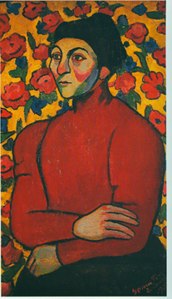
How did she start her career as an abstract artist?
After two years of art study in Germany, Sonia persuaded the Terks to let her go to Paris – the center of “it’s what’s happening” – for a year. In Paris she saw the work of van Gogh, Gaugain, and the Fauves. Many years later she wrote of what she learned from them… “The real new painting will begin when people will understand that color has a life of its own, that the infinite combinations of color have a poetry and a language much more expressive than the old methods. It is a mysterious language in tune with the vibrations, the life itself, of color. In this area there are new and infinite possibilities.”
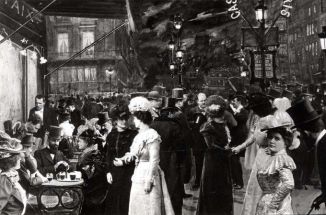
1900 Paris Cafe de la Paix. What do you notice in this picture? How is the fashion in 1900?
In Paris, Sonia met the young painter Robert Delaunay in 1907. They married and their son Charles was born January 1911. Robert’s early paintings had been influenced by impressionism and cubism but he and Sonia turned their attention jointly towards abstraction. Following the nineteenth-century chemist Michel Eugène Chevreul, who studied how the perception of colours seems to change when they are placed alongside each other, Sonia and Robert developed a theory of simultaneous colour contrasts which they called simultanism. Sonia began to apply these theories to a variety of forms. Shortly after the birth of their son Charles, she made him a patchwork cradle cover, bringing together the traditional techniques used by Russian peasant women with modernist abstraction.
“About 1911 I had the idea of making for my son, who had just been born, a blanket composed of bits of fabric like those I had seen in the houses of Russian peasants. When it was finished, the arrangement of the pieces of material seemed to me to evoke cubist conceptions and we then tried to apply the same process to other objects and paintings.”
In 1913 Sonia befriended the poet Blaise Cendrars. Together they created Prose on the Trans-Siberian Railway and of Little Jehanne of France 1913, in which the poet’s fictional recounting of a journey from Moscow to Paris is interpreted through Sonia’s abstract stencil illustrations.
The poem does not end at Harbin, the eastern terminus of the line, however, but in Paris, which is represented by the Eiffel Tower and the Big Wheel (La Roue) at the bottom. The Eiffel Tower, the tallest building in Paris, has also served as a radio tower since the early twentieth century. It is thus a symbol of Paris’s connection to the world as well as of modernity. Cendrars and Delaunay also intended another connection to the Eiffel Tower: they initially planned to print 150 copies of the book, which measures two meters long. If laid end-to-end, together they would have equaled the tower’s height.
The colour and dynamism of simultanism was particularly suited to capturing the remarkable energy of city life in the early twentieth century. Sonia’s Electric Prisms series explored the distinctive effects of electric lighting, while her studies of the Boulevard Saint Michel and her billboard projects for luxury brands such as Zenith show a fascination with the changing fabric of the urban landscape.
Sonia Delaunay in Simultaneous dress, c. 1913
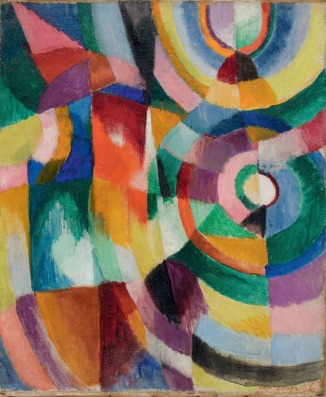
At the outbreak of the First World War, Sonia and Robert were on holiday in the Basque town of Hondarribia in northern Spain. They decided not to return to Paris and spent the next seven years travelling within Spain and Portugal.
While living in Spain, Sonia began to support herself and her husband by working as decorator.
After their return to Paris in 1920 Sonia was mainly active as designer of fabrics and clothes in styles related to her paintings. There was a huge demand for Sonia’s fabric designs, and she employed a team of Russian women to manufacture, knit and embroider her products. In 1925 she set up her own fashion house, and registered Simultané as a brand name in both France and the United States.
Sonia showcased her simultaneous designs at the 1925 International Exhibition of Modern Industrial and Decorative Arts in a pavilion called boutique simultané.
Look at the 1925 fashion showcased by these models. How does it compare with the 1900s?
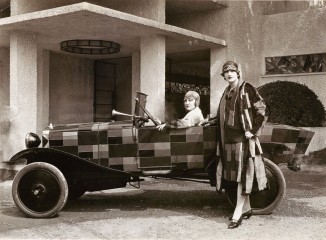
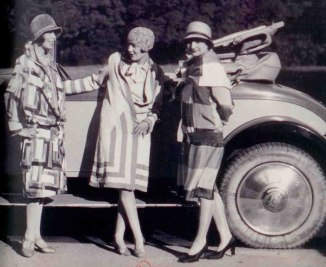
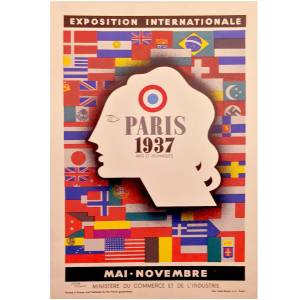
Sonia and Robert were both invited to contribute to the 1937 Paris Exhibition.
Entitled The International Exhibition of Arts and Technology in Modern Life, it was intended to celebrate scientific innovation and boost trade.
As a team, the Delaunays collaborated on both domestic interiors and set design, creating several impressive wall-sized murals for the Paris World’s Fair of 1937.
“I always changed everything around me… I made my first white walls so our paintings would look better. I designed my furniture; I have done everything. I have lived my art.”
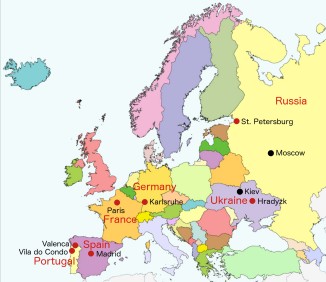
Where has she exhibited her work?
As well as a major retrospective at the Kunstmuseum Bielefeld in 1958, Delaunay was the first living female artist to have a retrospective exhibition at the Louvre in 1964. She has also had her work shown at Musée d’Art Moderne in Paris, Smithsonian Cooper-Hewitt, National Design Museum, Musée des Arts Décoratifs, Musée National d’Art Moderne and Tate Modern.
Let’s see Sonia’s colors at Musée d’Art Moderne de la Ville de Paris!
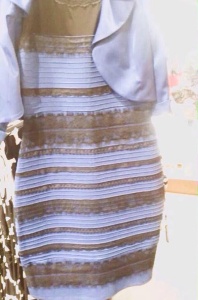
What color is this dress? – The art and science of color!
Color interaction was first put on a sound experimental base by the French chemist Michel Chevreul (1786-1889). Chevreul was hired by the Gobelin Tapestry factory to investigate the fading of their tapestry threads.
In his 1839 book, De la Loi du Contraste Simultané des Couleurs, Chevreul shows that the fading is not fading at all, but instead due to simultaneous contrast between adjacent colored threads.
For example, a grey will look lighter on a dark background than it does on a light one.
Demonstration of contrast sensitivity
You can also try this experiment at home: Color Contrast
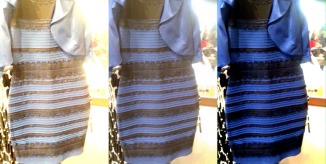
PROJECT: Black Paper, Oil Pastels (Light Design)
On black paper, using circles and other geometric shapes, organize the space with ruler lines and circles with protractors. Drwaing with a pencil, keep the space large enough to handle oil pastels and simple enough to make the designs intersect and incorporate many colors.















